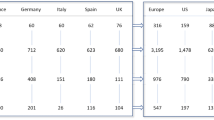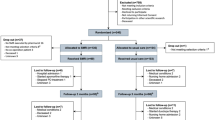Abstract
Background: The positive results of a randomised clinical trial of rivastigmine in patients with dementia associated with Parkinson’s disease have been published recently. Patient-level healthcare utilisation data were also collected, and this report is the economic evaluation based on these data.
Objective: To determine the cost effectiveness of rivastigmine 3–12 mg/day in patients in whom mild to moderate dementia developed at least 2 years after they received a clinical diagnosis of Parkinson’s disease.
Methods: A cost-effectiveness analysis was performed by applying Canadian and UK cost weights (year 2004 values) to healthcare utilisation data collected prospectively during a randomised, double-blind, multinational, 24-week trial of rivastigmine 3.12 mg/day (n = 362) versus placebo (n = 179). Patients were ≥50 years of age, had a Mini-Mental State Examination (MMSE) score of between 20 and 24 and had contact with a responsible caregiver at least 3 days a week.
Quality-adjusted survival time, transformed from MMSE scores, was the measure of effectiveness. Caregiver costs included paid and unpaid time, and direct costs included concomitant medications, outpatient care, hospitalisations, long-term care and study medications. Analysis was conducted from a societal perspective with a time horizon of 24 weeks.
Results: Consistent with the improvement in clinical outcomes, there was an observed increase in quality-adjusted survival time in the rivastigmine arm of 2.81 quality-adjusted life-days (two-sided p-value 0.13 [90% CI −0.243, 5.86]). Using Canadian price weights, there was an observed increase in cost in the rivastigmine arm of $Can55.76 (two-sided p-value 0.98 [90% CI −3431, 3543]), with a resulting incremental cost-effectiveness ratio of $Can7429 per QALY. Using UK price weights, there was an observed decrease in cost in the rivastigmine arm of £26.18 (two-sided p-value 0.99 [90% CI −2407, 2355]).
Conclusion: Although no between-treatment differences in cost were seen, the small sample size, highly variable cost distributions and short time horizon prevent us from making strong conclusions with regard to the effect of rivastigmine on total costs and, by inference, on cost effectiveness.














Similar content being viewed by others
References
Cummings JL. Intellectual impairment in Parkinson’s disease: clinical, pathologic and biochemical correlates. J Geriatr Psychiatry Neurol 1988; 1 (1): 24–36
Aarslland D, Andersen K, Larsen JP, et al. Prevalence and characteristics of dementia in Parkinson disease: an 8-year prospective study. Arch Neurol 2003; 60 (3): 387–92
Wolstenholme J, Fenn P, Gray A, et al. Estimating the relationship between disease progression and cost of care in dementia. Br J Psychiatry 2002; 181: 36–42
McKeith I, Del Ser T, Spano P-F, et al. Efficacy of rivastigmine in dementia with Lewy bodies: a randomized, double-blind, placebo-controlled international study. Lancet 2000; 356 (9247): 2031–6
Reading PJ, Luce AK, McKeith IG. Rivastigmine in the treatment of parkinsonian psychosis and cognitive impairment: preliminary findings from an open trial. Mov Disord 2001; 16 (6): 1171–4
Aarsland D, Laake K, Larsen JP, et al. Donepezil for cognitive impairment in Parkinson’s disease: a randomized controlled study. J Neurol Neurosurg Psychiatry 2002; 72: 708–12
Giladi N, Shabtai H, Gurevich T, et al. Rivastigmine (Exelon) for dementia in patients with Parkinson’s disease. Act Neurol Scand 2003; 108 (5): 368–73
Hutchinson M. Cholinesterase inhibition in Parkinson’s disease. J Neurol Neurosurg Psychiatry 1996; 61: 324–5
Small GW, Donohue JA, Brooks RL. An economic evaluation of donepezil in the treatment of Alzheimer’s disease. Clin Ther 1998; 20: 838–50
Lamb HM, Goa KL. Rivastigmine: a pharmacoeconomic review of its use in Alzheimer’s disease. Pharmacoeconomics 2001; 19 (3): 303–18
Garfield FB, Getsios D, Caro JJ, et al. Assessment of Health Economics in Alzheimer’s Disease (AHEAD): treatment with galantamine in Sweden. Pharmacoeconomics 2002; 20 (9): 629–37
Jönsson L. Pharmacoeconomics of cholinesterase inhibitors in the treatment of Alzheimer’s disease. Pharmacoeconomics 2003; 21 (14): 1025–37
Wimo A, Winblad B, Engedal K, et al. An economic evaluation of donepezil in mild to moderate Alzheimer’s disease: results of a 1-year, double-blind, randomized trial. Dement Geriatr Cogn Disord 2003; 15: 44–54
Wimo A. Cost effectiveness of cholinesterase inhibitors in the treatment of Alzheimer’s disease: a review with methodological considerations. Drugs Aging 2004; 21 (5): 279–95
Feldman H, Gauthier S, Hecker J, et al. Economic evaluation of donepezil in moderate to severe Alzheimer disease. Neurology 2004; 63 (4): 644–50
Fagnani F, Lafuma A, Pechevis M, et al. Donepezil for the treatment of mild to moderate Alzheimer’s disease in France: the economic implications. Dement Geriatr Cogn Disord 2004; 17: 5–13
Emre M, Aarsland D, Albanese A, et al. Rivastigmine for dementia associated with Parkinson’s disease. N Engl J Med 2004; 351 (24): 2509–18
Ontario Ministry of Health. Ontario Drug Benefit Formulary. Ottawa (ON): Ministry of Health, 1994
Ontario Case Cost Project. Ontario Case Cost Project (OCCP): Ontario guide to case costing, version 1.1. Sept. ed. Ottawa (ON): Ontario Case Cost Project, 1995
Ontario Ministry of Health. Schedule of benefits physician services under the Health Insurance Act. Toronto (ON): Queen’s Printer, 2004
Jabobs P, Assiff L, Bachynsky J, et al. A national list of provincial costs for health care: Canada 1997/98. Edmonton (AB): Institute of Health Economics, 2000
Statistics Canada. The consumer price index (catalogue no. 62-001-XIB [August]). Ottawa (ON): Ministry of Supply and Services, 2004
Statistics Canada. Table 282-0700: labour force survey (LFS) estimates, wages of employees by type of work, National Occupation Classification for Statistics (NOC-S), sex and age group, annual [online]. Available from URL: http://estat.stat-can.ca/ [Accessed 2004 Jun 10]
British National Formulary, BNF 47. London: British Medical Association and Royal Pharmaceutical Society of Great Britain, 2004 Mar
National Health Service reference costs. London: Department of Health, 2003
NHS Trust Financial Returns TFR2. London: Department of Health, 2004
Netten A, Curtis L. Unit costs of health and social care. Personal Social Services Research Unit. Canterbury: University of Kent, 2003
Office of National Statistics. New earnings survey. London: Office of National Statistics, 2003
Jönsson L. Economic evaluation of treatments for Alzheimer’s disease. Stockholm: Karolinsda Institutet, 2003
EuroQol: a new facility for the measurement of health-related quality of life: The EuroQol Group. Health Policy 1990; 16 (3): 199–208
Willan AR, Pinto EM, O’Brien BJ, et al. Country-specific cost comparisons from multinational clinical trials using empirical Bayesian shrinkage estimation: the Canadian ASSENT-3 Economic Analysis. Health Econ 2005; 14 (4): 327–38
Pinto EM, Willan AR, O’Brien BJ. Cost-effectiveness analysis for multinational clinical trials. Stat Med 2005; 24 (13): 1965–82
Fenwick E, O’Brien BJ, Briggs A. Cost-effectiveness acceptability curves: facts, fallacies and frequently asked questions. Health Econ 2004; 13 (5): 405–15
Willan AR, Lin DY. Incremental net benefit in randomized clinical trials. Stat Med 2001; 20 (11): 1563–74
Feeny D, Furlong W, Torrance GW, et al. Multi-attribute and single-attribute utility functions for the Health Utilities Index Mark 3 system. Med Care 2002; 40 (2): 113–28
Acknowledgements
Andrew Willan provided the overall supervision of the cost-effectiveness evaluation project, provided the direct supervision of the statistical analysis, and wrote the manuscript. Ron Goeree provided the direct supervision of the collection of price weights and wrote the corresponding sections of the manuscript. Eleanor Pullenayegum performed the statistical analysis and reviewed and made edits to the manuscript. Christopher McBurney supervised the conduct of the cost component of the EXPRESS (EXelon in PaRkinson’s disEaSe dementia Study) trial and reviewed and made edits to the manuscript. Gordon Blackhouse collected the Canadian price weights and merged these and the UK price weights with the utilisation data to determine the cost for individual patients. Dr Blackhouse also reviewed and made edits to the manuscript. The authors wish to thank Ms Susan Tomlinson and Ms Sara Quirk for their meticulous proofreading. Of course, all remaining errors are the authors’ own responsibility. The authors also wish to thank the editor and reviewers for their many helpful comments, which have led to a greatly improved manuscript.
Andrew Willan is funded through the Discovery Grant Program of the Natural Sciences and Engineering Research Council of Canada (grant number 44868-03) and Eleanor Pullenayegum is supported through a studentship by the Ontario Student Opportunity Trust Fund — Hospital for Sick Children Foundation Student Scholarship Program; however, the opinions expressed are those of the authors and should not be attributed to any funding agency. Funding support for the research reported in this article was received from Novartis. Dr McBurney is an employee of Novartis and owns stock in the company.
Author information
Authors and Affiliations
Corresponding author
Rights and permissions
About this article
Cite this article
Willan, A.R., Goeree, R., Pullenayegum, E.M. et al. Economic evaluation of rivastigmine in patients with Parkinson’s disease dementia. Pharmacoeconomics 24, 93–106 (2006). https://doi.org/10.2165/00019053-200624010-00008
Published:
Issue Date:
DOI: https://doi.org/10.2165/00019053-200624010-00008




